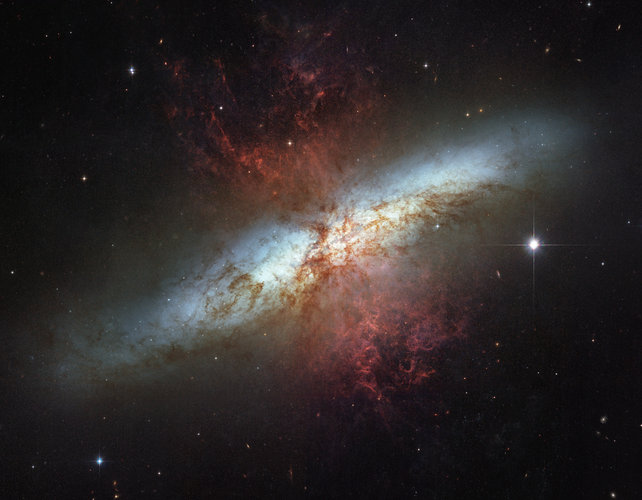A curious signal from a nearby galaxy
In November 2023 ESA’s Integral spotted a sudden explosion from a rare object. For only a tenth of a second, a short burst of energetic gamma-rays appeared from the direction of the bright galaxy M82.
The satellite data were received in the Integral Science Data Centre in Geneva, from where a gamma-ray burst alert was sent out to astronomers worldwide, only 13 seconds after its detection. The IBAS (Integral Burst Alert System) software gave an automatic localisation coinciding with the nearby galaxy M82.
Now it was up to astronomers to figure out what had happened; was this one of the more common gamma-ray bursts or a rare occasion of a giant flare from a magnetar?
“We immediately realised that this was a special alert. Gamma-ray bursts come from far-away and anywhere in the sky, but this burst came from a bright nearby galaxy,” explains Sandro Mereghetti of the National Institute for Astrophysics (INAF–IASF) in Milan, Italy, and lead author of a paper on this discovery.
The team requested ESA's XMM-Newton space telescope to perform a follow-up observation of the burst’s location as soon as possible. If this had been a short gamma-ray burst, caused by two colliding neutron stars, the collision would have created gravitational waves and have an afterglow in X-rays and visible light.
“XMM-Newton’s observations only showed the hot gas and stars in the galaxy. If this explosion had been a short gamma-ray burst, we would have seen a fading source of X-rays coming from its location, but this afterglow was not present,” adds co-author Michela Rigoselli from INAF.
“Using ground-based optical telescopes, including the Italian Telescopio Nazionale Galileo and the French Observatoire de Haute-Provence, we looked for a signal in visible light, starting only a few hours after the explosion, but again we did not find anything. With no signal in X-rays and visible light, and no gravitational waves measured by detectors on Earth (LIGO/VIRGO/KAGRA), we are certain the signal came from a magnetar,” concludes Sandro.
Jan-Uwe Ness, ESA’s Integral Project Scientist explains: “When unexpected observations like this are picked up, Integral and XMM-Newton can be flexible in their schedules, which is essential in time-crucial discoveries. In this case, if the observations had been performed even just a day later, we would not have such strong proof that this was indeed a magnetar and not a gamma-ray burst.”



